The science of social species goes under the microscope this week. We hear what radio-tagging individual ants is revealing about the way they organise their nests to decide who goes hunting and who stays at home. Meera explores the growth of urban apiculture, including why city-made honey tastes superior to its countryside equivalent, we find out how bees encountering hostility use a stop signal to deter their fellow foragers from befalling the same fate, and in Kitchen Science we explore the physics of flight to see how bees stay airborne. Plus why not cleaning your teeth could cause a heart attack, how early humans eschewed vegetarianism, mongooses that teach each other nut-cracking tricks and how to give a reef a coral transplant!
In this episode

01:37 - Caries and cardiac trouble
Caries and cardiac trouble
A large UK-based study has confirmed that not cleaning your teeth is a significant risk factor for having a heart attack.
 Writing in the British Medical Journal, UCL researcher Richard Watt and his colleagues followed the fortunes (or not) of nearly 12,000 Scottish adults, including both men and women, who were recruited to study the link between poor oral hygiene and arterial disease. After 8 years of follow up and 555 heart attacks later, analysis of the results shows that, irrespective of other risk factors, poor tooth-cleaning compliance results in a 70% increase in risk of suffering a coronary.
Writing in the British Medical Journal, UCL researcher Richard Watt and his colleagues followed the fortunes (or not) of nearly 12,000 Scottish adults, including both men and women, who were recruited to study the link between poor oral hygiene and arterial disease. After 8 years of follow up and 555 heart attacks later, analysis of the results shows that, irrespective of other risk factors, poor tooth-cleaning compliance results in a 70% increase in risk of suffering a coronary.
People who brushed less than twice a day, the team found, were 1.7 times more likely to have an arterial "event" than their more hygiene-conscious counterparts, a risk equivalent in scale to being diagnosed with high blood pressure.
Chronic low-grade gum and peridontal inflammation is believed to be the "root" cause, which accelerates the process of arterial injury and blockage. And although the link between oral hygiene and heart attacks had been made previously, most of the studies that have been carried out in the past have involv d identally-diagnosed periodontal (gum) disease.
What this study shows is that the answer to the question, "how often do you brush your teeth?" can be used as a simple to administer yet highly significant predictor of heart disease during routine screening by medical practitioners.
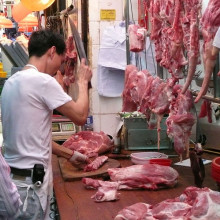
05:26 - Human ancestors gave up vegetarian diet 2 million years ago
Human ancestors gave up vegetarian diet 2 million years ago
New archaeological evidence suggests human ancestors gave up their vegetarian diet and began feasting on land and aquatic animals 2 million years ago, perhaps boosting their brain size in the process.
Butchered remains of crocodiles, turtles, and fish were found by David Braun from the University of Cape Town in South Africa and his team who excavated the Koobi fora formation in northern Kenya.
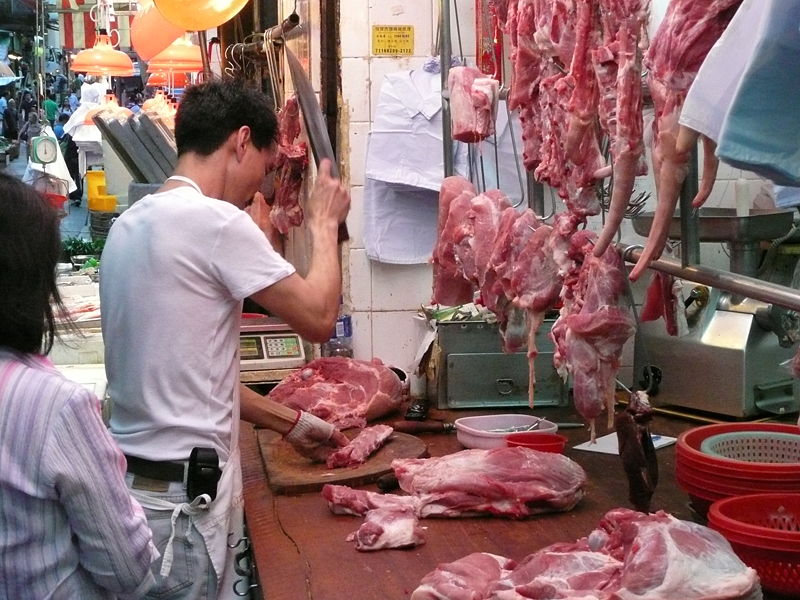 The findings, published in the journal PNAS, provide some of the earliest evidence for meat-eating among human ancestors.
The findings, published in the journal PNAS, provide some of the earliest evidence for meat-eating among human ancestors.
Cut marks on the fossilized bones, and evidence for bone marrow extraction, support theories it was stone tool-wielding humans that ate these animals and not other predatory animals.
No hominin bones were found in the formation so we can't be sure who the butchers were, judging by the timing it could have been Homo habilis or perhaps late australopithecines.
Aquatic species are especially rich in docosahexaenoic acid, a form of omega 3 fatty acid that is critical in human brain growth. It is possible that a diet rich in omega 3 could have played a role in the rapid development of brain size - that essential human characteristic. But for now we don't know if the world's first butchers were eating crocodiles and fish as part of a staple diet, or an occasional meaty treat.
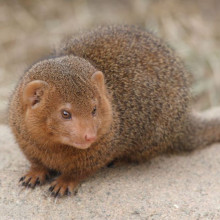
07:58 - Animal instinct, or tradition?
Animal instinct, or tradition?
Animals pass-on practical knowledge and learning to their counterparts, researchers have proved this week.
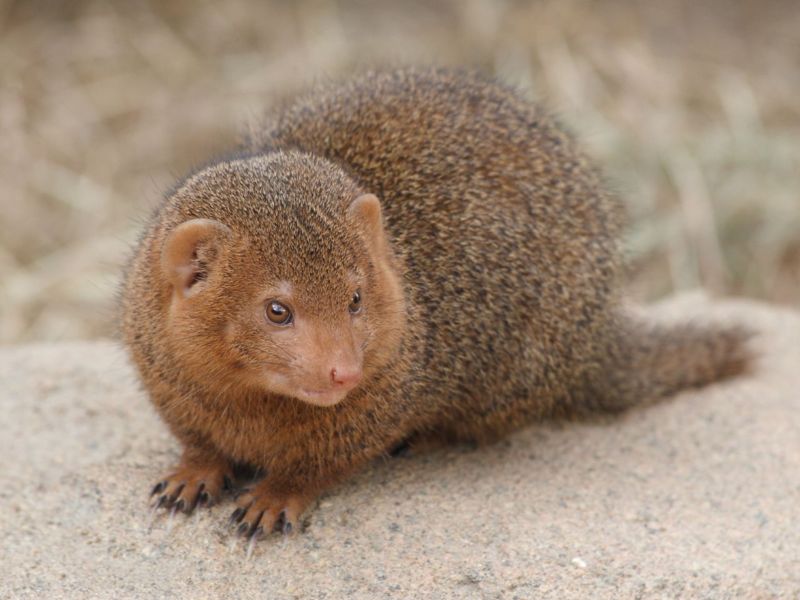 Amongst humans, we routinely talk about traditions passing down through the generations. But scientists usually assume that the majority of animal species are incapable of such a feat. With a few rare exceptions seen amongst certain marine mammals and other primates, the apparent transmission of specific skills or behaviours amongst simpler animals is usually labelled as "instinctive". But Exeter University researchers Corsin Muller and Michael Cant, who have been monitoring mongooses in Africa, have found that these small carnivores definitely influence their descendents with the fruits of their wisdom.
Amongst humans, we routinely talk about traditions passing down through the generations. But scientists usually assume that the majority of animal species are incapable of such a feat. With a few rare exceptions seen amongst certain marine mammals and other primates, the apparent transmission of specific skills or behaviours amongst simpler animals is usually labelled as "instinctive". But Exeter University researchers Corsin Muller and Michael Cant, who have been monitoring mongooses in Africa, have found that these small carnivores definitely influence their descendents with the fruits of their wisdom.
Mongooses make attractive study subjects for this kind of work because they are highly social animals that live in groups within which young pups pair up with older unrelated "escorts" whose job it is to show them the ropes for their first few months of life. They also have two separate strategies for opening up tough food morsels such as nuts or creatures that live in hard shells: they either gnaw holes in them or throw them at something hard until they break; but each animal tends to favour one of the two techniques.
To find out why, the researchers made modified "Kinder" surprise eggs containing a tasty fish and rice treat and initially filmed the escorts as they attempted to crack into them. Once they'd identified the escorts as "hurlers", "biters" or "both" they then began to present the treats to the escorts in front of their oung mongoose proteges, who watched as they opened them up to obtain the food. As a control, one group of animals were presented with already-open treats.
After the youngsters had observed their escorts opening treats ten times, the researchers then tested the young animals themselves with their own "Kinder" eggs. The strategy they used, the Muller and Cant found, tended to be the one they'd watched their escort use. But the "controls" that had watched their escorts eat from alre dy-open eggs favoured neither technique, indicating that they weren't just copying their escorts general behaviour. This, say the researchers, shows that the animals can clearly learn off each other, enabling them to transmit survival tips and techniques generationally...
11:51 - Transplanted corals could save reefs
Transplanted corals could save reefs
Transplanting coral fragments broken off by storms could be a simple, cheap, and effective way of restoring small areas of damaged reef.
The equivalent on land would be if twigs broken off trees during a storm could be stuck in the ground and left to sprout into new trees.
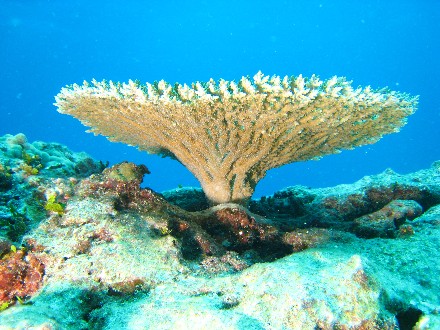 A team of researchers led by Graham Forrester from the University of Rhode Island in the US have published a study in the journal Restoration Ecology that assesses how well coral transplantation works to help healthy reefs grow back.
A team of researchers led by Graham Forrester from the University of Rhode Island in the US have published a study in the journal Restoration Ecology that assesses how well coral transplantation works to help healthy reefs grow back.
White Bay in the British Virgin Islands in the Caribbean was the study site and threatened elkhorn coral - Acropora palmata - was the focus species, which as its name suggests, grows in a branching form like deer antlers and get easily damaged by storms.
The research team, with the help of students and local residents, dived down and picked up living coral fragments after a storm, then took them to another site where elkhorn corals had been wiped out by a deadly disease in the 80s and 90s - as they have across much of the Caribbean region.
Fragments were fixed in place using underwater cement, epoxy resin, and plastic cable ties.
Four years later, 40% of the transplanted coral was still alive, despite them being hit by a storm and two coral bleaching events - when increased sea temperatures cause corals to loose the vital, symbiotic algae that live in their tissues. The broken coral fragments had much better survival chances when they were transplanted and fixed in place, compared to fragments left lying on the seabed.
Crucially, the transplanted corals had grown large enough to become sexually mature, so these new reefs should be able to start seeding other nearby reefs with larvae.
This method is straightforward and cheap, but it is nevertheless labour intensive and not a viable option for large areas of reef - imagine trying to replant the Great Barrier Reef. But it certainly offers an option for boosting reef health on a local scale making them more resilient to the bigger, global problems reefs face including climate change, pollution, and overfishing.
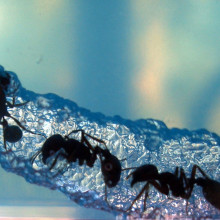
15:15 - The Hive Mind - How Ants Know Their Place
The Hive Mind - How Ants Know Their Place
with Dr Elva Robinson, Univeristy of York
Chris - Now this week, we're looking at some of the creatures that live a colonial lifestyle and not just humans, but bees and ants. It's an incredibly complicated world inside an ant colony, with different types of ant doing lots of different jobs. In order to shed some light on what's going in there, researchers have found some interesting ways to follow individual ants around their colonies, and that includes gluing tiny radio tags onto each ant. Dr. Elva Robinson, from York University, is doing just that to find out how a colony comes to a decision, and she's with us today. Hello, Elva.
Elva - Hello, Chris.
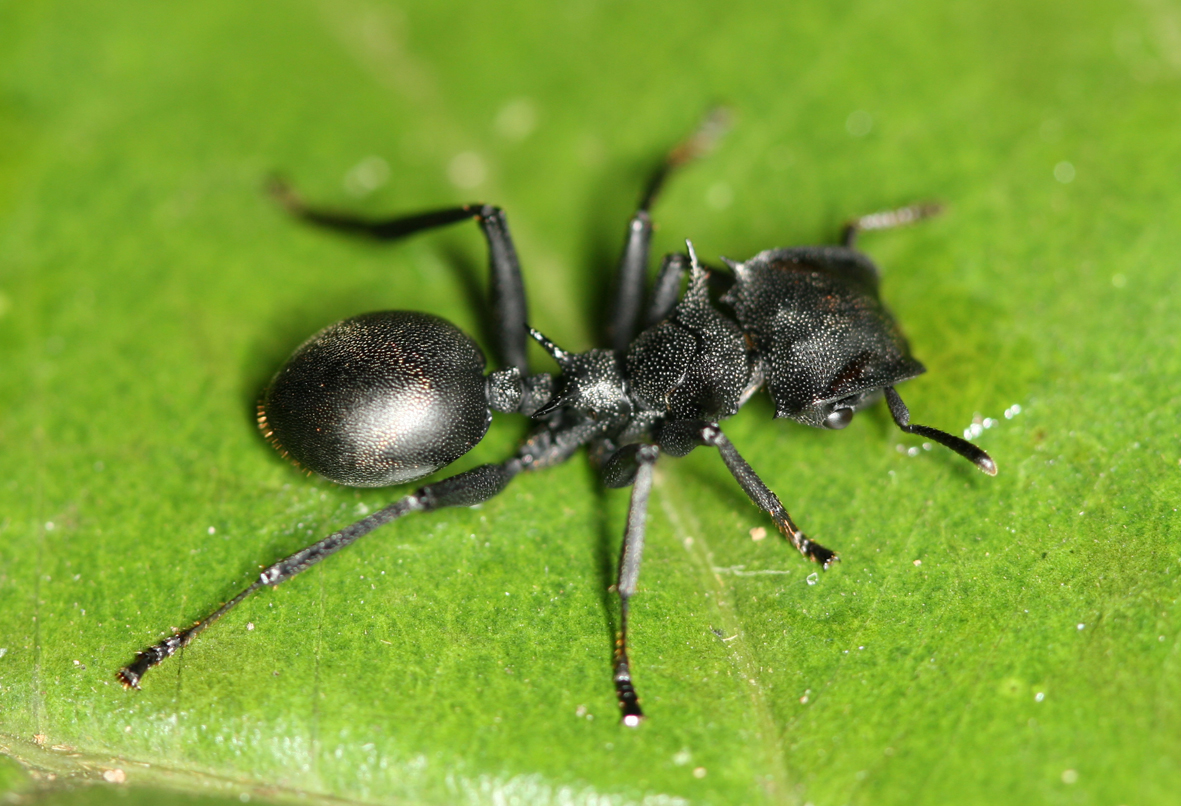 Chris - Welcome to the Naked Scientists. Thank you very much for joining us. First of all, the question that must be going through everyone's mind - how on earth do you glue a radio tag to an ant?
Chris - Welcome to the Naked Scientists. Thank you very much for joining us. First of all, the question that must be going through everyone's mind - how on earth do you glue a radio tag to an ant?
Elva - Well, it's a very fiddly process and obviously, it has to be done under a microscope because the ants that I have been tagging are just 2 to 3 millimetres long, and the radio tags themselves are just half a millimetre across. Without a microscope, they just look like little bits of glitter.
Chris - And how do you stick them on?
Elva - Well I use just a very tiny, tiny amount of glue and put that onto the thorax of the ant and then placed the tag on top of that.
Chris - So Araldite or should I say Aral-mite perhaps?
Elva - (Laughs) It is Araldite that we use actually, yes.
Chris - And what did this show? What were the questions you were trying to answer by tagging these ants?
Elva - I'm very interested in how colonies organise themselves and how the individual ants contribute to the overall collective processes in the colony. The great thing about the RFID system is that it's possible to uniquely tag every ant in the colony so that each tag has got its own unique ID. So when an ant passes the RFID reader, I know which ant it is and where it is and what time it's been there.
Chris - Talk us through the experiment. So this is in a laboratory colony of ants, presumably, because it will be almost impossible to try and do this out in someone's garden...
Elva - Yes. With these tags, because they're so very small, they don't have a very long read range. So at the moment, it's only appropriate for laboratory use. We have several colonies in the lab. What I was interested in with this particular experiment is how the ants decide which job to do in the colony. You've got some ants which are looking after the broods and some which are caring for the queen, and others which might be patrolling the nest, constructing the cavity or going out and searching for food. I'm interested in how the ants decide which job to do and in this experiment, I changed the demand for particular jobs - for foraging and also for brood care - and looked at which ants switch to take on that extra job.
Chris - How do the ants know that x number of ants have gone out of the colony or that there's a certain amount of food out there they have to bring in? How is that message relayed around the colony?
Elva - That's the very interesting thing because the individual ants don't have any overall idea of those kind of things - of how much food is available or how much food is required. So, one of the things we're interested in is how does an ant know that it should go out and forage? And the RFID system meant I was able to look at a whole lot of different factors affecting the ants because I knew for each ant, where it had been before in the nest, and what jobs it had been doing previously. Also, I knew how old it was - the ant, and I knew how much fat it had got stored. I was then able to look and see which ants went outside and foraged when I increased the demand for foragers, and how that was predicted by all those different factors.
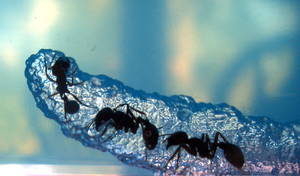 Chris - So is it a bit like humans, where we give the menial jobs to people who are pretty junior and we give the important jobs to the senior ones? Is there a pecking order in the ants or does it work out some other way?
Chris - So is it a bit like humans, where we give the menial jobs to people who are pretty junior and we give the important jobs to the senior ones? Is there a pecking order in the ants or does it work out some other way?
Elva - Well yes, it's not quite like that. There are age differences in what jobs the ants do, so it does tend to be the older ants that go outside and forage. But what our study showed was that there's also big differences in how much fat is stored in the individual ants, and the fat stores are very valuable to the colony. So we found that although on average, the younger ants had more fat than the older ants, there was a lot of overlap in the distribution. And we found that it was the amount of fat that an ant had stored that was much more important than any of the other factors in determining whether an ant went outside.
Chris - So how do ants size each other up then? Do they have some kind of pheromone that's responsive to how much fat they've got on board and the fatter they are basically, the lazier they are because they get to stay indoors?
Elva - We don't really know what the mechanism of this is yet, but it's quite possible that the ant is able to perceive its own fat level through some kind of internal physiological hormonal process or even through its physical weight as it moves around. An ant only needs to be able to perceive its own weight, not that of the other ants in the colony. We suggest that as an ant gets leaner, it becomes more likely to go outside and forage. But this isn't just because it's getting more hungry because what the ants tend to do is go outside and forage, collect food, and then bring it back and pass it on to the other ants in the colony which were already quite fat, and those ants will then convert the new food to fat and store it. The other ants will remain lean and carry on foraging.
Chris - Is that because foraging is risky and when you go outside, there's a reasonably high chance that you're not going to come home?
Elva - That's a possible ultimate evolutionary explanation for what we're seeing. That the fat ants are very valuable to the colony and the lean ants are less valuable, and also, if they're older, they're less valuable. They might get lost through predation or they might just get blown away when they're outside foraging. But interestingly, what we found is that for the same level of fat, it didn't actually matter whether the ant was an older ant or a younger ant. So the age per se didn't really matter. It was the amount of fat stores. But on average, the older ants are leaner, so it is older ants which were going out, but it's not because of their age. It's because of their fat stores.
Chris - Apart from obviously being extremely academically interesting to understand how these complex colonies work - because there are thousands of individuals in the colony, aren't there? Are there any ways in which this can inform the big picture? Can we make human systems, computers and so on work better because of understanding how these organisms organise themselves?
Elva - These ants are great examples of self-organisation because each ant is making a decision based only on the information that it has about itself. It doesn't have to know the overall system of the colony and that's quite an important lesson for lots of human systems where we tend to focus a lot on centralised control where you have one control centre collecting all the information and deciding what to do. But obviously, if there's a problem with that control centre then your whole system will break down. For ants, decisions are processed in a very distributed way, so all the individuals contribute. And if any one individual is taken out of the system, it will still work. So in the case of our experiment, if some ants were removed as we did in our experiment, then the next leanest ants will go out. And if you keep on removing ants then more and more corpulent ants - more fat ants - will start to go outside. So it's all very self regulating.
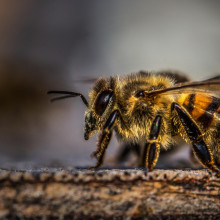
22:35 - Urban Beekeeping
Urban Beekeeping
with Alison Benjamin, Urban Bees
Helen - Another insect famous for its colonial behaviour is the honeybee, and the keeping of these bees, otherwise known as apiculture, by members of the general public has grown dramatically in recent years with the British Beekeepers' Association seeing a 40% increase in memberships over the last year. But more interestingly, the number of people keep bees in our cities has also gone up 5-fold from 30 to 150 people joining the London Beekeepers' Association in the last four years. We sent Meera Senthilingam to find just what the buzz is about.
Meera - The honeybee plays a vital role in the pollination of our crops and our wild flowers, as well as producing delicious honey. But it's well-known that their population is in decline. One way to help the situation is to keep bees yourself, something that, in the past, was thought to be confined to the countryside. But now, the field of urban beekeeping is increasingly growing in popularity. To find out more, I've come along to Camley Street Nature Park in London where beekeeping company Urban Bees are currently running a course on keeping bees in an urban environment. With me is one of the co-founders of Urban Bees, Alison Benjamin.
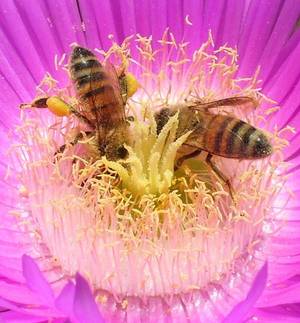 Alison - A hive is made up of three different types of bees. There's predominantly the worker bee which is a female honeybee. There's about 50,000 of them at the height of the summer. Then there's the queen, again - female, and her job very much is to lay eggs. And there are the drones, a few hundred drones or the male bees who don't do very much at all apart from impregnate a virgin queen. Actually, at the end of the summer, the worker bees chuck them out of the hive. You have to think of a bee colony as a super-organism. So, in the way that we're made up of cells, a bee colony is made up of bees. The queen isn't actually in control of the beehive. She is very much a slave to the colony.
Alison - A hive is made up of three different types of bees. There's predominantly the worker bee which is a female honeybee. There's about 50,000 of them at the height of the summer. Then there's the queen, again - female, and her job very much is to lay eggs. And there are the drones, a few hundred drones or the male bees who don't do very much at all apart from impregnate a virgin queen. Actually, at the end of the summer, the worker bees chuck them out of the hive. You have to think of a bee colony as a super-organism. So, in the way that we're made up of cells, a bee colony is made up of bees. The queen isn't actually in control of the beehive. She is very much a slave to the colony.
Meera - So you have the three different types, but within that, there are specialised roles for them within their colonies.
Alison - When the bees are first born, they come out and their sting isn't developed, their various glands to make wax aren't developed, so they do special duties in the hive like cleaning the cells out so the queen can lay another egg in that cell. They might be feeding the queen, or cleaning the queen. They'll be spending about 3 weeks in the hive and as they grown older, probably for the last of that week, they'll be guard bees, so they'll be at the entrance of the hive making sure that bumble bees or other creatures don't stray in, or keeping wasps away. And then they'll spend 3 weeks out foraging for nectar.
Meera - What about the structure of the hive itself? So we're here at the Camley Street Nature Centre. There are four hives here. They're about 2 foot square. They're just a box shape really. Unfortunately, it is pouring down with rain, so there are no bees out and about, they're all inside, but how, if I was to be able to see inside this hive, would it be structured?
Alison - If you take the lid off, what you'd see is what's called the brood box which is where the queen, her workers and the babies live, and they live on honeycomb. So you will have 11 frames of honeycomb.
Meera - And these are basically just flat sheets.
Alison - Yes, they're flat sheets of wax that we actually give the bees. They draw out this flat comb, so it becomes 3D, and then they use that as chambers in which the queen will lay eggs, in which the larvae will develop and in which they'll store their honey and their pollen.
Meera - So once the bees are here, the hive is here, so what then happens when the bees are sent out and about? What are they foraging for? What are they bringing back?
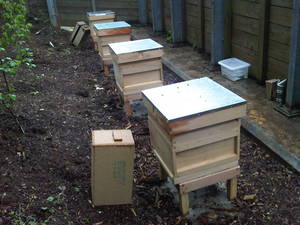 Alison - Well the bees are basically going out to get as much nectar and pollen as they can to feed the larvae that are developing in the hive. Basically, they're attracted to the flowers by the nectar that the flowers are producing. When they go to collect the nectar, they then inadvertently pollinate the plants. As well as bringing back the nectar to the hive which is their carbohydrate, the energy to feed the babies and themselves, they're also bringing back pollen which is the protein that they'll feed the larvae. Each bee will survive for about 6 weeks during the summer, so they need to replenish the dying bees.
Alison - Well the bees are basically going out to get as much nectar and pollen as they can to feed the larvae that are developing in the hive. Basically, they're attracted to the flowers by the nectar that the flowers are producing. When they go to collect the nectar, they then inadvertently pollinate the plants. As well as bringing back the nectar to the hive which is their carbohydrate, the energy to feed the babies and themselves, they're also bringing back pollen which is the protein that they'll feed the larvae. Each bee will survive for about 6 weeks during the summer, so they need to replenish the dying bees.
Meera - What's the life cycle of these different bees and what happens over winter then when they're not out collecting?
Alison - They survive about 6 weeks in summer because it's said that they fly for about 500 miles before they're completely exhausted and die on the wing. So, if they're not out, in the winter, they tend to huddle inside the hive to keep warm, and only come out on warm days. So they can survive October through to April really during the winter, but there's only about 10,000 of them during the winter, compared to about 50,000 in the summer.
Meera - So, only a fifth of them really are left to keep the hive going over winter?
Alison - Yes, that's right.
Meera - You now specialise in producing these hives in an urban environment. We are truly in an urban environment now. There are trains going past, there are motorcycles on the road just outside the park, but what do you need to consider when adapting all of this to an urban environment?
Alison - You do have to consider whether you've got enough space if you were then to keep them in your back garden or on your roof terrace. It's not just the hive itself, which is about 2 foot square. There's quite a lot of paraphernalia that goes with beekeeping. The suit, the extra boxes because the hive grows throughout the summer when you're giving them boxes for the honey. Obviously, you need to be aware of neighbours.
Meera - On average, how much honey does a typical hive produce? As there might be lots of people that do tend to keep bees, who wanted to do so for the honey.
Alison - It's a variety of reasons actually. Some people do it just because the bees are in trouble. Environmentally, they just like the idea of keeping a creature that's out there pollinating, but obviously, some people do keep it for the honey as well, and an average hive can make about 40 pounds of honey throughout the summer.
Meera - And would you say there's much of a difference keeping them in an urban environment?
Alison - People do say that the honey in urban environments now is better than honey from the countryside because there's such a rich diversity of flowers and plants in the parks, in people's gardens, just along tree-lined roads and railway sidings. Whereas in the countryside, you may have acres of land that's planted with just one crop. Also, that isn't a very good diet for your bee if they're just surviving on one crop, so they can suffer from malnutrition where they tend to be quite strong in the cities.
Do animals really learn from one another?
Malc was referring to this news story, about an experiment where young Mongooses (Mongeese?) appeared to learn from their elders the technique for getting into fiddly food items.
Chris - It's a good point. These animals obviously know how to pick things up and they know how to manipulate them in their paws, so that's instinctive. But how they actually choose to break into the object is obviously something they pick up from an adult. The researchers did control for that instance that you've raised because by giving the escort animal the open egg, the young pups didn't have to watch an adult breaking into it. So therefore, when they came to open one themselves, they either chose to smash it on something or to gnaw into it. And they showed equal numbers of them doing either, showing there was no bias. So they do it by instinct, but they choose to do one thing or the other based on what they're shown how to do in certain situations by an adult or an older animal.
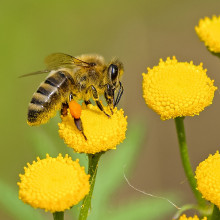
30:28 - Ready, Steady, Stop!
Ready, Steady, Stop!
with James Nieh, University of California at San Diego.
Helen - Bees communicate in a number of ways, including that wonderful famous waggle dance that they use to indicate where all the best bits of food are. In February 2010, researchers discovered that honeybees also have a warning signal that they use to tell each other to avoid certain areas, and it shows us that their language is really much more complicated than we already thought. Dr. James Nieh led the team from the University of California at San Diego that made that discovery and he joins us now. Hello, James. Thanks for joining us on the Naked Scientists.
James - Hello. Thank you. It's a pleasure.
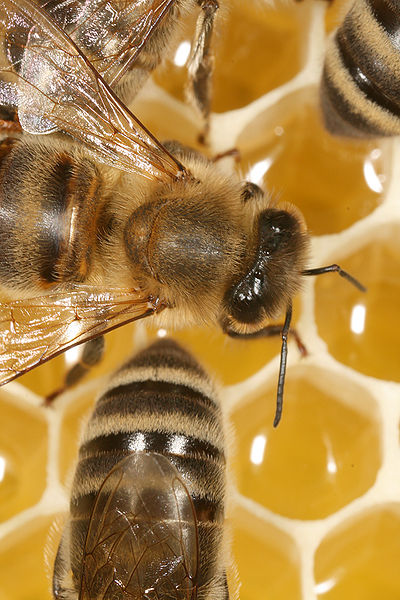 Helen - So, tell us more about this new "stop sign" that you've discovered in honeybees.
Helen - So, tell us more about this new "stop sign" that you've discovered in honeybees.
James - We've known for a long time that honeybees face various perils at food sources. For example, they're often attacked by ambush predators such as crab spiders, which you can sometimes see in your garden flowers. They're cleverly camouflaged to look like the same colour of the flower. We've known recently that this danger affects [the bees] ability to waggle dance so that they try to recruit fewer bees to food sources which they perceive to be dangerous. But what we didn't realise is that there's another system at play that allows a bee that's been attacked to warn other bees about her situation and we looked at this in two contexts. One, in terms of competition from other bees for a natural food source - which happens, although it's somewhat more rare, you can occasionally see bees from different colonies, fighting over a good food source. Secondly, what happens when bees are exposed to signals of danger such as alarm pheromones or being physically attacked by a predator.
Helen - So how did you go about looking at these ideas you had? Were you looking at bees in the laboratory or were these wild bees flying around in the open air?
James - We had a bee colony in the laboratory and we were able to see inside through the glass, what the bees were doing. We had them trained to an artificial feeder so that we could control the situation more carefully. Occasionally, we had feral bees that would come and would try to take over the feeder. We had an assistant who was removing these feral bees. All the bees that we had trained were marked and were identified so we can tell if they come back to the colony, that they are from our colony. Now, what we would do sometimes is we would let the feral bees continue to feed at the feeder. We would not remove them and then we would see these fights ensue. Sometimes the feral bees would attack our bees and in that case, the bees actually came back and they produce this curious signal called the "stop signal" where they go around and they will target a bee that's been visiting the same location. We know that it's based on the odour of the food source. So she'll target that bee. She will jam her head up against the bee that's waggle dancing for that location and give this brief piping sound that causes the waggle dancer to momentarily freeze. She will then reduce the number of waggle runs that she receives, depending in part upon the number of these stop signals that she gets.
Helen - So essentially, these bees have found, they've detected a problem, something that they're scared off out in their foraging area, they come back and they essentially tell everyone else to stop. They turn down almost the volume of those announcements that are going out, telling bees to go back to that site. So it's almost damping down that signal that goes out to say, "Go out and look at this particular flower" because actually, it's going to be quite dangerous.
James - Exactly and maybe some of your listeners are wondering, "Well why would she give up so easily?" and it's interesting that she doesn't. Initially, our bees attack the feral bees and try to retain control of the feeder. And when they do so, they actually don't produce stop signals. In fact, it seems that they actually ramp up the recruitment of nest mates. But when that tide of battle turns and as more and more bees are attacked, they come back and report this by producing stop signals, so that when eventually, it's impossible for them to win the battle, and to keep the feeder, they stop recruiting for it.
Helen - So we've got the waggle dance, we've got stop signals. Do we have any feeling that there are other ways that the bees are communicating that we're still going to discover?
James - That's an interesting point. There are some interesting behaviours. There's something called the tremble dance which is highly correlated with the stop signal. We're not sure exactly what it means, but it does in some context re-allocate labour inside the colony. So you have this super organism as
your previous speaker talked about in which they have different tasks. But there's no single bee that controls all of this and is telling them what to do. So there necessarily are these signals that help to reallocate labour for where it's needed. The tremble dance is one of those signals where we're not really sure what's going on. There's also another signal called the "shaking" signal which again seems to re-allocate labour, but again, we're not exactly sure what it does. So there are quite a few mysteries that remain.
Helen - As you say, lots of mysteries remain, but we are learning a little bit more to understand that language of the bees. But we also know that a lot of bees are facing quite a big problem at the moment, and we hear more and more about colony collapse disorder, and I believe that's something that you're looking into as well. Is language going to come in to our understanding of what's going on and why bees are facing problems today?
James - Well, we've been looking at the effect of this pesticide which is often sprayed on plants. It's sold in Europe and the United States as Gaucho but it's known by its chemical name, imidacloprid. It's actually been banned in some EU countries now because it's thought to be associated with bee death. This is again one of the dangers that bees face when they forage. They could come in contact with the pesticide and bring back small quantities. Now, there is a lethal dose of any pesticide, and it's thought that this was not so detrimental to bees, but we've been finding that extremely minute quantities of these pesticides when ingested by bees can actually affect their behaviour. Other research has shown that it seems to affect their waggle dance behaviour. They don't seem to waggle dance as much when coming back, after receiving this pesticide. But we were interested in two things; we know that in colony collapse disorder, we have this strange situation of a colony that's depleted. It's sort of like the Mary Celeste, you come aboard, everything is empty and where have the bees gone? There are no dead bodies of bees around, as you would have in a normal disease. So one of the things we wondered is whether or not there is a nutritional imbalance that's occurring.
What we found in our preliminary studies is that bees that receive very small quantities of this pesticide develop what we call a picky eater syndrome. In humans, this is akin to someone not wanting to eat certain things, and actually, typically eating things that are unhealthy. In terms of bees, what we find is that the bees who would now normally accept relatively low sugar concentrations, what you typically find in nectar are shifted. They become extremely picky and they will only consume the sweetest nectars. Now you might think this wouldn't be bad but in the environment, you don't often have your pick of food, and if you're going to reject most of what's available, that means that less sugar, fewer calories are entering the colony. There is a second aspect as well which also relates to human picky eaters syndrome. There's a nutritional imbalance. Bees need to collect pollen and nectar. Pollen is providing them with their protein and interestingly enough, pollen foragers are ones that genetically are predisposed to not be picky about sugar. In other words, they will feed at very low sugar concentrations, and of course, they'll collect pollen. We suspect that what will happen, and we're doing these experiments right now, is that when pollen foragers are fed very minute quantities of this pesticide, they will actually shift away from collecting pollen because now, they will develop an appetite more similar to that of nectar foragers. And if you have a colony where few bees are collecting pollen, you're going to have a nutritional problem, there won't be sufficient brood, and the colony will eventually decline.
Helen - Well that's all absolutely fascinating stuff. Thanks very much, James. That was James Nieh from University of California, San Diego, telling us about how bees communicate, how learning to really understand their language, and most importantly, how we're really starting to unpick, that it isn't just if things like pesticides can stray it out, kill insects like bees, but if it interrupts their ability to talk to each other and makes them picky eaters, that could also explain why so many colonies of bees are doing very badly at the moment.
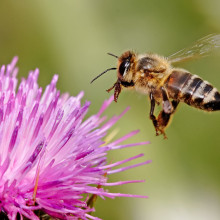
Can Bees Fly? - Insect Aerodynamics
Why do some species have thousands of sterile individuals?
We posed this question to Elva Robinson from the University of York...
Elva - In some species of ants, there are workers that are completely sterile although in many species of ants, bees and termites, the workers can actually reproduce a bit, but not as much as the queen. This posed a problem for Darwin when he was thinking about evolution by natural selection because usually, evolution should move individuals towards the best chance of passing on their own genes directly to the next generation. Obviously, sterile worker ants can't do that. But they are, of course, very closely related to the queen who is their mother, and actually, because of ant genetics, they're more closely related genetically to their mother than we are to our own mothers, because ant genetics work slightly differently. So, this means that their genes will be passed on to the next generation through their siblings, through their sisters, the future queens of other colonies, and through the males that that colony produces. Chris - So it's less "selfish gene", it's more that the genes will go on, but you have to be there to help the genes flow from somebody else. But because you're closely related to them doesn't matter? Elva - Yes and we call it kin selection; acting in the interests of the family when it's very closely related. There are also big efficiency benefits for these ant colonies because of the way they organise their division of labour. So they can very efficiently help their siblings to reproduce.
Could radio signals or mobile phone masts confuse bees?
We posed this question to James Nieh from the University of California at San Diego...
James - There was an original study in India that created these questions and interest, and what they did is they actually put a radio cell phone transmitter inside the hive, but it really wasn't done with very many colonies and the results were ambiguous. They were not statistically significant. I actually have looked at this paper. In addition, the authors have said that their results were too broadly interpreted. So I would say, the answer is that there really is no scientific evidence that cell phone towers or other types of electromagnetic radiation from communications devices harm bees. In addition, there are many areas that are afflicted by colony collapse disorder that do not have cell phone towers that are nearby. So it's not thought to be a good link.
What happens if a bee or ant gets lost from its colony?
We posed this question, with reference to bees, to James Nieh from the University of California at San Diego and, with reference to ants, to Elva Robinson from the University of York... James - Bees do vary in their acceptance of bees by their colonies. In general though the guard bees smell bees that are coming in and if they detect a difference from their colony odour that's significant, they will reject that bee or even try to kill it. So, very often, these bees will be rejected. However, the way that many beekeepers work is they take one colony and they divide it over subsequent years. So in fact, there is a kind of relatedness among these different colonies, and if they are sister colonies, there is a good chance that a lost worker bee will be accepted.
Elva - It does vary depending on how closely [the ant colonies] are related and most ants are very hostile to ants coming in from other colonies. So usually, they would fight and kill that ant. But there are some species of ants which form networks of connected colonies where the colonies bud off and produce new colonies which pretty much stay in contact, so they're colonies made up of lots of different connected nests. So then, an ant that got lost could go into any nest and it would be fine.
What is the cause of colony collapse disorder?
We posed this question to James Nieh from the University of California at San Diego...
James - It's definitely a part of colony collapse, which we think of as having four features. One are parasites like Varroa destructor, the mite. Pesticides are thought to be involved, viral and bacterial diseases, and then finally, management practices which are not optimal. We're actually moving bees around a lot. It's startling that in one month, about 80% of all bee colonies in North America converged in Central California for agricultural pollination, and this can be very stressful because they're packing bees together and they're moving them around, and worker bees don't orient very well to a new location. They tend to get lost.
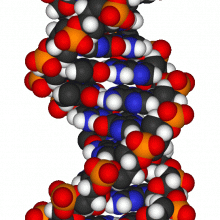
51:23 - Are memories encoded in our genes?
Are memories encoded in our genes?
We posed this question to Professor Wolf Reik from the Babraham Institute in Cambridge...
Wolf - This depends what kind of memories we're talking about. We work on epigenetic memory which is really the memory in the genome, epigenetic markers in the genome, and that can be passed on from cell to cell, so that cells, when they divide, basically remember what they were before. This is going on all the time, this kind of epigenetic memory. All of the cells that we have in our body carry this kind of memory of their identity, of what they are, of what tissue they are, and this is really important because if that memory goes wrong for example, the outcome can be cancer.
And then, is it possible that the environment and things that we experience is laid down in memories in the brain? That's certainly the case. Is that through epigenetic mechanisms? Maybe.
Then to extend the question even further, is it possible that those memories that get laid down in the brain as part of an epigenetic mechanism could be inherited by our children and grandchildren? I think that's a big leap, kind of theoretically possible, but remember that brain cells are very specialised. The things that get laid down in the brain cells predominantly happens after birth.
Diana - So epigenetic memory can be inherited by cells and help them to become liver cells, heart cells, or even brain cells. But the things we experience through life create memories and they're recorded in or between our brain cells, and brain cells would've divided following the instructions from their epigenetic memory. But this epigenetic memory would've been written before your parents had collected any memories in the first place. Wolf - And at that point, the germ cells, the egg or the sperm which then transmit the genetic and epigenetic information to children and grandchildren are already formed, and are far away from the brain. And so, the short answer is that the things that happen to the brain, and may even involve epigenetic mechanisms to consolidate memory, in my view are not so likely to be passed on to our children and grandchildren.
Diana - Perhaps you can inherit epigenetic memory from your parents, but not memories from their very varied and interesting lives. There has been quite a bit of research on worm epigenetics. A team in Massachusetts in the USA found that worms which experience stress whilst developing would pass on different epigenetic information to its offspring than those which had been happy larvae. And some people think that humans who underwent stresses like malnutrition during development might pass their epigenetics onto future offspring too.










Comments
Add a comment